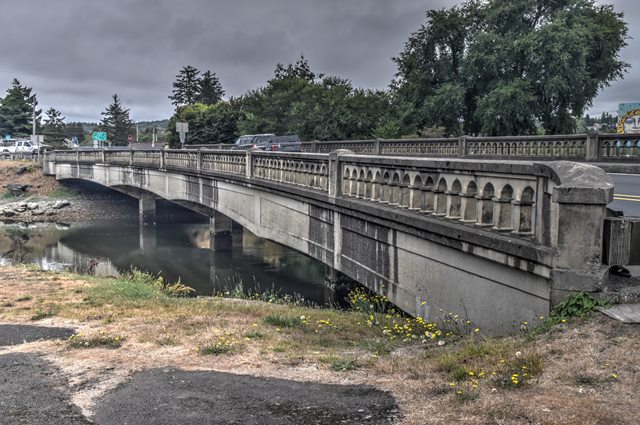We Recommend:
Bach Steel - Experts at historic truss bridge restoration.
Neawanna Creek Bridge

Primary Photographer(s): Nathan Holth
Bridge Documented: September 1, 2018
Seaside: Clatsop County, Oregon: United States
1930 By Builder/Contractor: F. L. Odom and Engineer/Design: Conde Balcom McCullough (Oregon State Highway Commission)
Not Available or Not Applicable
52.5 Feet (16 Meters)
210.0 Feet (64 Meters)
27 Feet (8.23 Meters)
4 Main Span(s)
1305

View Information About HSR Ratings
Bridge Documentation
View Archived National Bridge Inventory Report - Has Additional Details and Evaluation
View Historic American Engineering Record (HAER) Documentation For This Bridge
This concrete t-beam bridge is noted for its use of a then-new engineering theory in its design. It also has an attractive visual design, something that its designer, the noted Conde McCullough was famous for.
The bridge was documented by the Historic American Engineering Record who provided the following information:
Significance: The Neawanna Creek Bridge #1305 is significant as an intact example of a 1930s continuous concrete, multi-span highway bridge, utilizing Hardy Cross's moment distribution theory, and for its association with C.B. McCullough, Oregon's premier bridge engineer. The configuration of continuous concrete T-Beam construction utilized in the design of the 1930 Neawanna Creek Bridge represents a significant change in structural engineering theory and reinforced concrete technology by applying the moment distribution technique of distributing loads on girder structures. The moment distribution theory for continuous concrete frames was developed in the late 1920s by Hardy Cross, a civil engineer and professor of structural engineering at the University of Illinois. Hardy Cross was regarded by his contemporaries as a leader in a new school of thought in the field of structural analysis, and his theory is regarded by many architects and engineers to be one of the more significant structural theories developed during the 20th century. C.B. McCullough served as State Bridge Engineer, and later as the Assistant State Highway Engineer, of Oregon from 1919 until his death in 1946. He authored a number of books and technical articles on bridge design and construction. McCullough is significant for his use of innovative bridge technology, and for his visually appealing designs. He had attained international recognition for the large-scale structures designed to span the major rivers and estuaries along the Oregon coast for the completion of the Orange Coast Highway in the 1930s.
![]()
Photo Galleries and Videos: Neawanna Creek Bridge
Bridge Photo-Documentation
Original / Full Size PhotosA collection of overview and detail photos. This gallery offers photos in the highest available resolution and file size in a touch-friendly popup viewer.
Alternatively, Browse Without Using Viewer
![]()
Bridge Photo-Documentation
Mobile Optimized PhotosA collection of overview and detail photos. This gallery features data-friendly, fast-loading photos in a touch-friendly popup viewer.
Alternatively, Browse Without Using Viewer
![]()
Maps and Links: Neawanna Creek Bridge
Coordinates (Latitude, Longitude):
Search For Additional Bridge Listings:
Bridgehunter.com: View listed bridges within 0.5 miles (0.8 kilometers) of this bridge.
Bridgehunter.com: View listed bridges within 10 miles (16 kilometers) of this bridge.
Additional Maps:
Google Streetview (If Available)
GeoHack (Additional Links and Coordinates)
Apple Maps (Via DuckDuckGo Search)
Apple Maps (Apple devices only)
Android: Open Location In Your Map or GPS App
Flickr Gallery (Find Nearby Photos)
Wikimedia Commons (Find Nearby Photos)
Directions Via Sygic For Android
Directions Via Sygic For iOS and Android Dolphin Browser
USGS National Map (United States Only)
Historical USGS Topo Maps (United States Only)
Historic Aerials (United States Only)
CalTopo Maps (United States Only)

